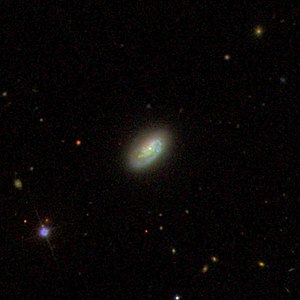NGC 5372
| Galaxy NGC 5372 |
|
|---|---|

|
|
| SDSS recording | |
| AladinLite | |
| Constellation | Big Bear |
|
Position equinox : J2000.0 , epoch : J2000.0 |
|
| Right ascension | 13 h 54 m 46.0 s |
| declination | + 58 ° 40 ′ 01 ″ |
| Appearance | |
| Morphological type | S? / HII |
| Brightness (visual) | 13.0 likes |
| Brightness (B-band) | 13.9 likes |
| Angular expansion | 0.6 ′ × 0.4 ′ |
| Position angle | 140 ° |
| Surface brightness | 11.3 mag / arcmin² |
| Physical data | |
| Affiliation | LGG 360 |
| Redshift | 0.005727 +/- 0.000043 |
| Radial velocity | 1717 +/- 13 km / s |
|
Stroke distance v rad / H 0 |
(82 ± 6) · 10 6 ly (25.2 ± 1.8) Mpc |
| history | |
| discovery | Wilhelm Herschel |
| Discovery date | April 24, 1789 |
| Catalog names | |
| NGC 5372 • UGC 8843 • PGC 49451 • CGCG 295-024 • MCG + 10-20-46 • IRAS 13530 + 5854 • GC 3711 • H III 809 • h 1709 • LDCE 1005 NED005 | |
NGC 5372 is a 13.0 mag bright spiral H-II galaxy of the Hubble type S? in the constellation Great Bear and about 82 million light years from the Milky Way.
It was discovered on April 24, 1789 by Wilhelm Herschel with an 18.7-inch reflector telescope, who described it as "vF, vS".
